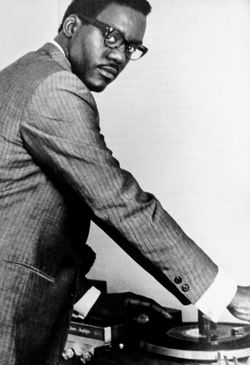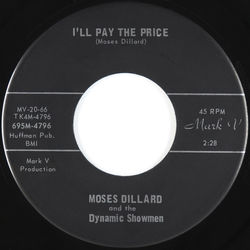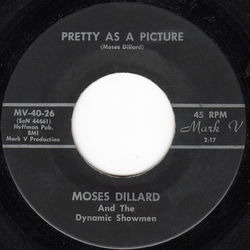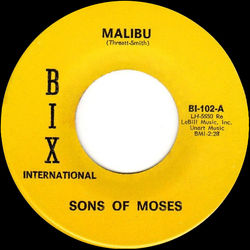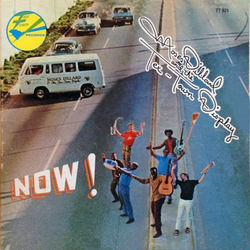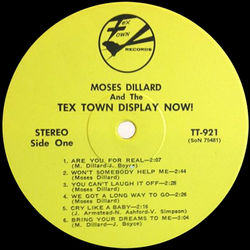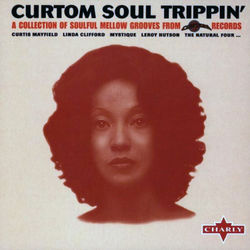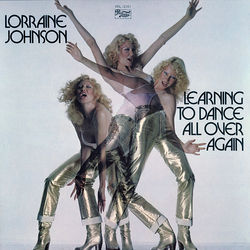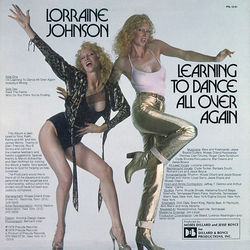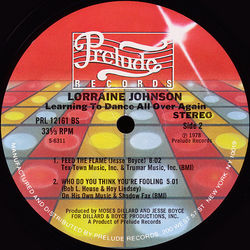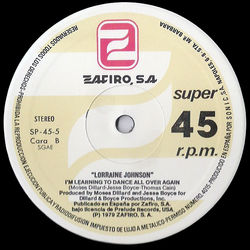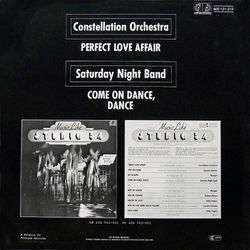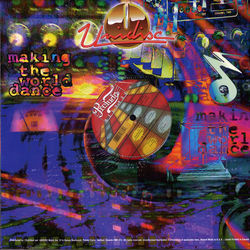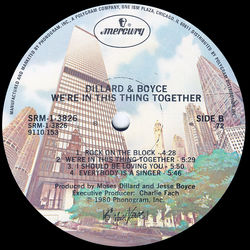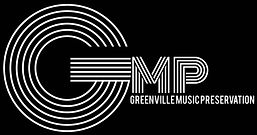



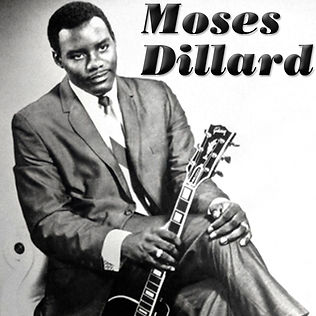
Most musicians can only hope to live a life of artistic accomplishment, spiritual fulfillment, and personal satisfaction but Moses Dillard is that rare exception, he did just that.
The deeper I researched into his 4 decade career the more my respect and awe grew for this man. Names like Jesse Boyce, Curtis Mayfield, Peabo Bryson, and Al Green, these are giants in the music industry and Moses was right there with them.
A very special thank you to Chandra Dillard for giving me permission to post this showcase for her father and to Jack Hines and the Greenville Music Preservation society for allowing me to use this article, by far the most in depth and detailed biography of this man’s life and career that exists on the internet.
Article by Jack A. Hines, courtesy of the Greenville Music Preservation society:
Moses Dillard began a recording career at Mark V Studios that would put him in the company of many of the legends of soul and R’n’B music and win him a Grammy and a Dove award. The bands he organized helped launch the careers of some of the biggest names in music to emerge from Greenville, SC. The story of his life and career parallel the changes that were taking place throughout the United States. It is a life impressive in its scope and accomplishments
Dillard was born in Greenville. His daughter, SC State Representative, Chandra Dillard, recounts memories of his childhood that have been shared with her.
“He started on guitar when he was twelve and he was something like a little prodigy,” said Rep. Dillard. “He started under the tutelage of a man named Bill Dover, the Bill Dover Band. My grandmother would let him go play with Mr. Dover because my father was such a good guitar player and Mr. Dover was the adult in the situation. He could look out for him. They would play at weddings and at the country club. And even going back 70 years, the country club crowd will tell you that they knew my father. My grandmother told him, “You go play on Saturday night as long as you’re in church on Sunday.”
Church for the Dillard family was the United House of Prayer for All People. The United House of Prayer is an Apostolic Holiness denomination with a unique musical tradition. The church, founded in Charlotte, NC by the Reverend Charles Manuel Grace, arose from the Pentecostal Holiness movement of the 1910’s and 20’ s. A singular musical style developed in their worship services that centered on syncopated rhythms and emotive, trombone-led brass bands. The style is a close cousin to early New Orleans jazz, but it developed on its own and is still played in Houses of Prayer today. It is hard to imagine that his experiences with this music did not make a significant impact on the young Moses Dillard.
Art Adams is a Greenville drummer with a long musical resume. He played in Dillard’s groups through the 60’s and 70’s and formed the proto- hip hop/funk group Point of View in the 80’s. He continues to perform with his group, the Carolina Beach Boyz today. While he and Dillard were still in high school, Adams started drumming for a local singer named Cornell Blakely. Blakely had recorded a single for Barry Gordy’s other label, Rich Records. Blakely enjoyed some local fame.
“At first it was just a summer job with Cornell, just me and a guitar player named Billy Joe Goodman, great guitar player and singer. Cornell took us to Cleveland, TN and then we went to play in Chattanooga. While we were there, we had to get Billy Joe a guitar because he pawned his in Cleveland and didn’t tell anybody. Anyway, when we got back to Greenville, I told Cornell that I knew a trombone player in the high school band named Moses Dillard and they say he plays guitar too.”
They added Dillard and keyboardist Jesse Boyce to the band and continued working in Tennessee. The band soon decided they could do just as well back home, though, and they left Cornell Blakely and returned to Greenville.
Back in town, they picked up Dillard’s brother Henry Dillard on saxophone and booked a regular Wednesday night gig at the Ghana Club and Sunday nights at Spartanburg’s Robin Hood Club.
“Then we started recording at Mark V studios with Joe Huffman at the old studio that was right there by the Meadowbrook ball park. First song we recorded was with a guy named James Poole, J. Poole, and a guy named Dwight McCombs. They were both from West Greenville, young kids. Then we went to Mark V on White Horse Road after they got big and started making money. That’s when we started doing most of the recording with the Moses band.”
The “Moses band” was Moses Dillard and The Dynamic Showmen. This group cut a handful of singles at Mark V Studios. Records like Pretty as a Picture and I’ll Pay the Price walk a line between tightly arranged soul and funky pop, somewhat reminiscent of Motown records from that period.
Jack Clark worked the boards at Mark V for a period in the mid-60’s. He remembers Moses Dillard as a talented guitarist and a consummate professional in the studio.
“Moses was a great guitar player. One day Moses just happened to be in the studio with me and he picked up an acoustic guitar. He sat there and played an absolutely great arrangement of Malaguena. Playing that on guitar is quite an accomplishment, something very few guitar players ever master.”
Dillard and the band were around Mark V Studios a lot in those days. They backed up gospel quartets and Dillard wrote and produced for vocal talent that he brought into the studio. Studio manager Joe Huffman tells the story of one singer.
“I remember Moses brought in this one girl, Carolyn Sullivan. He said she had a great voice but he didn’t really have a song for her. Well, he started pumping on this thing on the organ, this rhythmic thing and I spewed out some words. About fifteen minutes later we had a song. We were working with a guy in Texas and he shot it out and Phillips Records picked it up. It went to number one in San Francisco for like six weeks.”
Dillard and the band moved on from Greenville to Pensacola, Florida and became the studio band there for Don Schroeder’s record label, Amy/Mala/ Bell Records. There they backed up many of the biggest names in soul music in the late 60’s and 70’s; James and Bobby Purify, Sam and Dave and others.
“In fact, Moses had to go out with Sam and Dave and sing as Dave because Dave was drunk all the time,” remembers Adams.
The musicians settled back in Greenville eventually and reformed their band as The Tex-Town Display, adding Bill Wilson from Charleston, SC along with Greenville’s Peabo Bryson.
While performing at Vorhees College in Denmark, SC, The Tex Town Display made the acquaintance of a young man named Lenny Springs. Springs graduated from Vorhees in 1968, moved to Greenville and rekindled his acquaintance with Dillard and the band. He soon began to manage the group’s business affairs. He also connected with Dillard in another area of mutual concern, civil rights. The two men became leading members of the Black Council for Progress. The organization was a grassroots effort to expand voting rights and end some of the persistent segregation that still plagued some Greenville institutions. Rep. Chandra Dillard highlighted the significance of the Black Council for Progress’s work.
“They were so progressive. They are the ones who really ushered in single member voting districts like the district that I represent. So, I am able to serve as a result of the work of the Black Council for Progress. And they helped African Americans get into corporate jobs. I remember seeing golf clubs in the house and I figured that daddy was always doing strange things. But, he was actually going out trying to integrate (Greenville’s) Bonnie Brae golf course.”
Notable civil rights activist and future NAACP national chairperson William Gibson was also a member of the Council. Lenny Springs would also go on to membership in the NAACP national board and a successful business career.
The Tex Town Display had a hit with the song Got to Find a Way to Hide My Hurt in 1970. This led to a gig performing with the Miss Black America Pageant and a tour with the winner, Gloria O. Smith. They toured the world with the pageant on a USO package, even traveling to Vietnam to perform for the troops there.
The band moved around extensively in the early 70’s. They went to Atlanta and recorded for Bill Lowry’s Ken-Tell Records. From there they went to Chicago and recorded with Curtis Mayfield, playing on his seminal track Move On Up.
Eventually, Jesse Boyce left the band to work at Muscle Shoals studio and perform on records by Aretha Franklin. Boyce then joined the touring band of Little Richard and performed with him for years. He and Dillard settled in Nashville later and formed the duo Dillard and Boyce, releasing a few records.
Peabo Bryson signed on with soul label Bang Records, moved on to Capitol and recorded several hits before performing in Disney movie soundtracks and winning two Grammy awards.
Moses Dillard continued working in music, cutting records with Dillard & Boyce as well as performing and producing gospel and soul records. Somehow, in between all his musical exploits, Dillard found a way to attend Vanderbilt University, receive a degree in divinity and become a minister. He won a Grammy and a Dove award for a gospel record he produced for soul legend Al Green in 1983. He died unexpectedly of a heart attack in 1993. His longtime business manager, Lenny Springs, remembers getting the news.
“I had spoken to Moses just before I left to go to the NAACP national convention in Houston. He told me that he had just finished an album for a gospel singer and that he was going to send me a track. So, I left to go to Houston and while I was there, I got a call telling me Moses was dead, that he had a heart attack. Man, it rocked me,” he pauses. “Well, when I got back (home) to Charlotte there was the track and a note from Moses in the mail. I still have it.”
The life of Moses Dillard was that of a man with many facets and a very big heart. His cultural and historical importance to Greenville goes too often unsung.
1966
Moses Dillard & The Dynamic Showmen
Written by Moses Dillard.
Recorded and released by Mark V studio in Greenville, SC.
1969
The Sons Of Moses
Written by Moses Dillard.
Released 1969 on Bix International
1969
Moses Dillard and the Tex-Town Display
Written by Moses Dillard.
Released on Tex-Town Records
1971
Moses Dillard and the Tex-Town Display
Produced and written by Moses Dillard
Released on Curtom
1972
Moses Dillard, Martha Starr and Tex-Town Display
Written by Moses Dillard
Produced by Moses Dillard and Rod Kinder
Released on Shout
1972
Lorraine Johnson
Produced by Jesse Boyce and Moses Dillard
Written by Jesse Boyce
Released on Prelude Records
1972
Bill Brandon
Produced by Moses Dillard and Jesse Boyce
Written by Moses Dillard and Jesse Boyce
Released on Prelude Records
1975
Moses Dillard and Love Joy
Written by Moses Dillard
Produced and written by Moses Dillard
Released on 123
1978
Constellation Orchestra
Produced by Jesse Boyce and Moses Dillard
Written by Jesse Boyce and Moses Dillard
Released on Prelude Records
1979
Saturday Night Band
Produced by Jesse Boyce and Moses Dillard
Written by Jesse Boyce and Moses Dillard
Released on Prelude Records



